stop start Hyundai Matrix 2004 Owner's Manual
[x] Cancel search | Manufacturer: HYUNDAI, Model Year: 2004, Model line: Matrix, Model: Hyundai Matrix 2004Pages: 317, PDF Size: 5.12 MB
Page 9 of 317
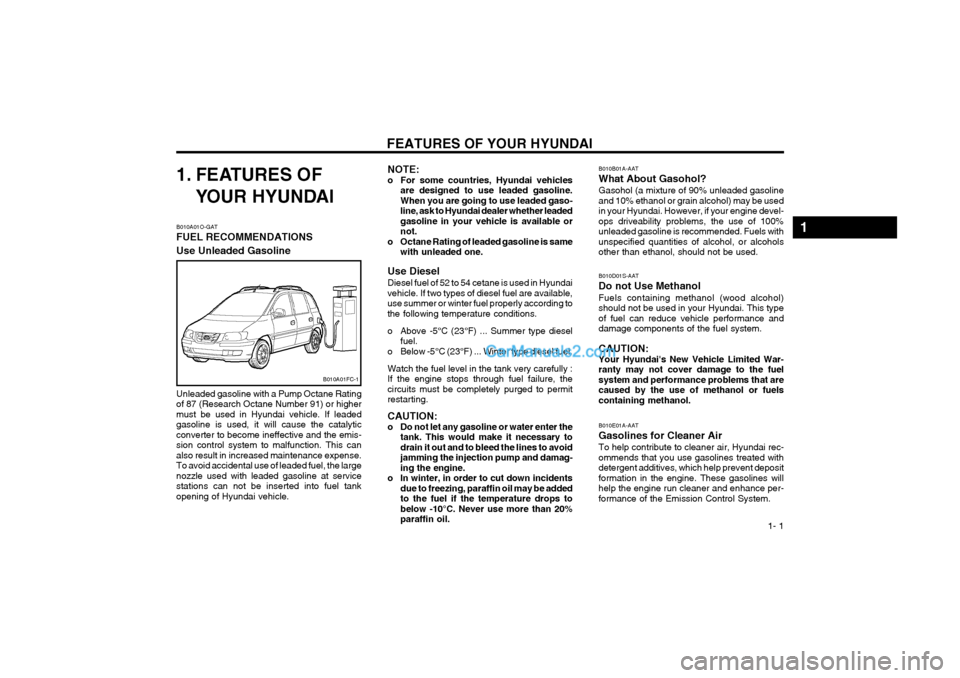
FEATURES OF YOUR HYUNDAI 1- 1
1. FEATURES OF
YOUR HYUNDAI
B010A01FC-1
B010A01O-GAT FUEL RECOMMENDATIONS Use Unleaded Gasoline Unleaded gasoline with a Pump Octane Rating of 87 (Research Octane Number 91) or highermust be used in Hyundai vehicle. If leadedgasoline is used, it will cause the catalyticconverter to become ineffective and the emis-sion control system to malfunction. This canalso result in increased maintenance expense.To avoid accidental use of leaded fuel, the largenozzle used with leaded gasoline at servicestations can not be inserted into fuel tankopening of Hyundai vehicle. NOTE:
o For some countries, Hyundai vehicles
are designed to use leaded gasoline.When you are going to use leaded gaso-line, ask to Hyundai dealer whether leadedgasoline in your vehicle is available ornot.
o Octane Rating of leaded gasoline is same with unleaded one.
Use Diesel Diesel fuel of 52 to 54 cetane is used in Hyundai vehicle. If two types of diesel fuel are available,
use summer or winter fuel properly according tothe following temperature conditions.
o Above -5°C (23°F) ... Summer type diesel fuel.
o Below -5°C (23°F) ... Winter type diesel fuel.Watch the fuel level in the tank very carefully : If the engine stops through fuel failure, thecircuits must be completely purged to permitrestarting. CAUTION:
o Do not let any gasoline or water enter the tank. This would make it necessary todrain it out and to bleed the lines to avoidjamming the injection pump and damag-ing the engine.
o In winter, in order to cut down incidents due to freezing, paraffin oil may be addedto the fuel if the temperature drops tobelow -10°C. Never use more than 20%paraffin oil. B010B01A-AAT What About Gasohol?Gasohol (a mixture of 90% unleaded gasoline and 10% ethanol or grain alcohol) may be usedin your Hyundai. However, if your engine devel-ops driveability problems, the use of 100%unleaded gasoline is recommended. Fuels withunspecified quantities of alcohol, or alcoholsother than ethanol, should not be used. B010E01A-AAT Gasolines for Cleaner Air To help contribute to cleaner air, Hyundai rec- ommends that you use gasolines treated withdetergent additives, which help prevent depositformation in the engine. These gasolines willhelp the engine run cleaner and enhance per-formance of the Emission Control System.
B010D01S-AAT Do not Use Methanol Fuels containing methanol (wood alcohol) should not be used in your Hyundai. This typeof fuel can reduce vehicle performance anddamage components of the fuel system. CAUTION: Your Hyundai's New Vehicle Limited War-
ranty may not cover damage to the fuelsystem and performance problems that are
caused by the use of methanol or fuelscontaining methanol.
1
Page 10 of 317

FEATURES OF YOUR HYUNDAI
1- 2
B030A01E
B030A01A-AAT KEYS For greater convenience, the same key oper- ates all the locks in your Hyundai. However,because the doors can be locked without a key,carrying a spare key is recommended in caseyou accidentally lock one key inside the car.
o Don't let the engine idle longer than 3 min-
utes at one time.
o Don't tow a trailer during the first 2,000 km (1,200 miles) of operation.
B010F01A-AAT Operation in Foreign CountriesIf you are going to drive your Hyundai in another country, be sure to:
o Observe all regulations regarding registra-tion and insurance.
o Determine that acceptable fuel is available. B020A01S-GAT BREAKING IN YOUR NEW HYUNDAI During the First 2,000 Km (1,200 Miles)(Gasoline Engine) No formal "break-in" procedure is required with your new Hyundai. However, you can contrib-ute to the economical operation and durabilityof your Hyundai by observing the followingrecommendations during the first 2,000 km(1,200 miles).
o Don't drive faster than 88 km/h (55 mph).
o While driving, keep your engine speed (rpm, or revolutions per minute) between2,000 rpm and 4,000 rpm.
o Use moderate acceleration. Don't start, de- press the accelerator pedal fully.
o For the first 300 km (200 miles), try to avoid hard stops.
o Don't lug the engine (in other words, don't drive so slowly in toohigh a gear that theengine "bucks": shift to a lower gear).
o Whether going fast or slow, vary your speed from time to time. B020B01FC-GAT BREAKING IN YOUR NEW HYUNDAI During the First 1,000 Km (600 Miles)(Diesel Engine) No formal "break-in" procedure is required with your new Hyundai. However, you can contrib-ute to the economical operation and durabilityof your Hyundai by observing the followingrecommendations during the first 1,000 km(600 miles).
o While driving, keep your engine speed (rpm,
or revolutions per minute) within 3,000 rpm.
o While driving, keep under three quarters of maximum speed.
o Use moderate acceleration. Don't start, de- press the accelerator pedal fully.
o For the first 300 km (200 miles), try to avoid hard stops.
o Don't lug the engine (in other words, don't drive so slowly in too-high a gear that the engine "bucks": shift to a lower gear).
o Whether going fast or slow, vary your speed from time to time.
o Don't let the engine idle longer than 3 min- utes at one time.
o Don't tow a trailer during the first 1,000 km (600 miles) of operation.
Page 41 of 317
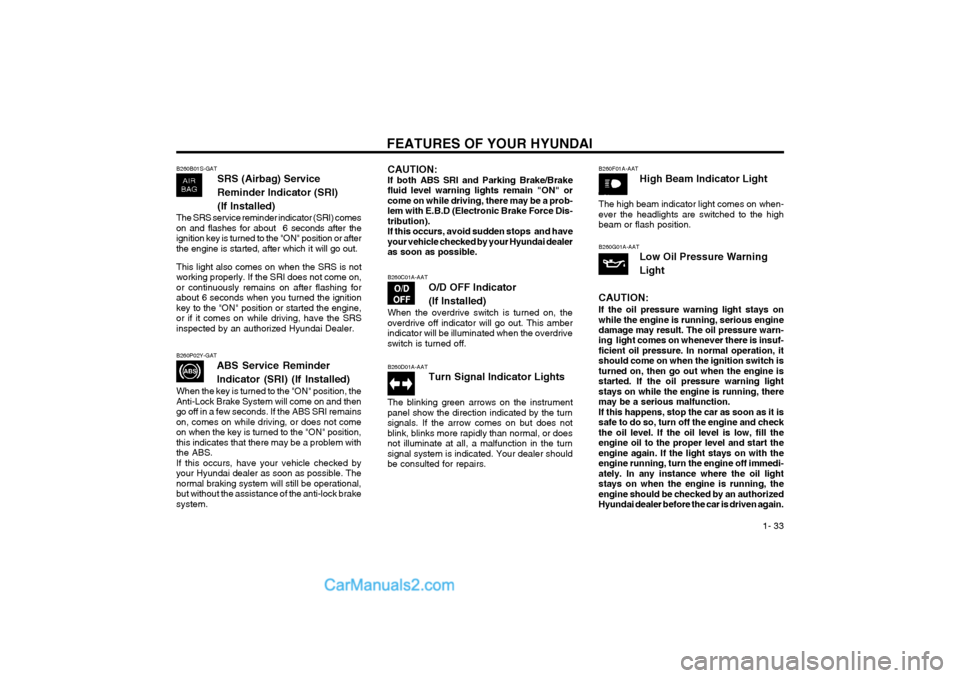
FEATURES OF YOUR HYUNDAI 1- 33
B260B01S-GAT
SRS (Airbag) Service Reminder Indicator (SRI)(If Installed)
The SRS service reminder indicator (SRI) comes on and flashes for about 6 seconds after theignition key is turned to the "ON" position or afterthe engine is started, after which it will go out. This light also comes on when the SRS is not working properly. If the SRI does not come on,or continuously remains on after flashing forabout 6 seconds when you turned the ignitionkey to the "ON" position or started the engine,or if it comes on while driving, have the SRSinspected by an authorized Hyundai Dealer. B260C01A-AAT
O/D OFF Indicator
(If Installed)
When the overdrive switch is turned on, the overdrive off indicator will go out. This amberindicator will be illuminated when the overdriveswitch is turned off.
B260P02Y-GAT
ABS Service Reminder
Indicator (SRI) (If Installed)
When the key is turned to the "ON" position, the Anti-Lock Brake System will come on and thengo off in a few seconds. If the ABS SRI remainson, comes on while driving, or does not comeon when the key is turned to the "ON" position,this indicates that there may be a problem withthe ABS.If this occurs, have your vehicle checked byyour Hyundai dealer as soon as possible. Thenormal braking system will still be operational,but without the assistance of the anti-lock brakesystem.
B260F01A-AAT High Beam Indicator Light
The high beam indicator light comes on when- ever the headlights are switched to the highbeam or flash position.
B260D01A-AAT Turn Signal Indicator Lights
The blinking green arrows on the instrument panel show the direction indicated by the turnsignals. If the arrow comes on but does notblink, blinks more rapidly than normal, or doesnot illuminate at all, a malfunction in the turnsignal system is indicated. Your dealer shouldbe consulted for repairs. B260G01A-AAT
Low Oil Pressure Warning Light
CAUTION: If the oil pressure warning light stays on while the engine is running, serious enginedamage may result. The oil pressure warn- ing light comes on whenever there is insuf- ficient oil pressure. In normal operation, itshould come on when the ignition switch isturned on, then go out when the engine isstarted. If the oil pressure warning lightstays on while the engine is running, theremay be a serious malfunction.If this happens, stop the car as soon as it issafe to do so, turn off the engine and checkthe oil level. If the oil level is low, fill theengine oil to the proper level and start theengine again. If the light stays on with theengine running, turn the engine off immedi-ately. In any instance where the oil lightstays on when the engine is running, theengine should be checked by an authorizedHyundai dealer before the car is driven again.
CAUTION: If both ABS SRI and Parking Brake/Brakefluid level warning lights remain "ON" orcome on while driving, there may be a prob-lem with E.B.D (Electronic Brake Force Dis-tribution).If this occurs, avoid sudden stops and haveyour vehicle checked by your Hyundai dealeras soon as possible.
Page 42 of 317
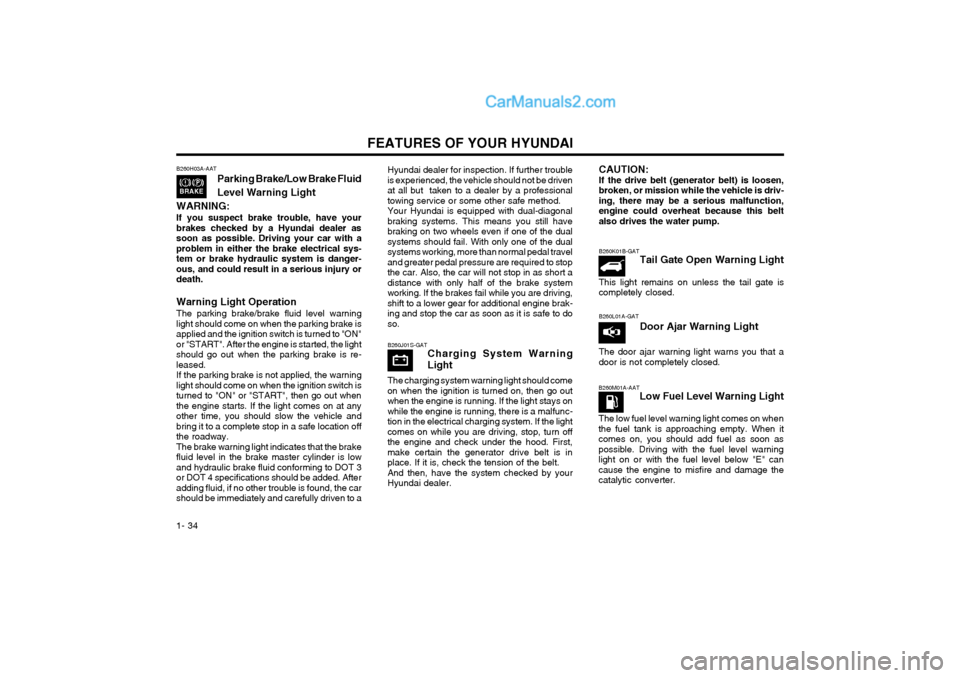
FEATURES OF YOUR HYUNDAI
1- 34 B260J01S-GAT
Charging System Warning Light
The charging system warning light should come on when the ignition is turned on, then go outwhen the engine is running. If the light stays onwhile the engine is running, there is a malfunc-tion in the electrical charging system. If the lightcomes on while you are driving, stop, turn offthe engine and check under the hood. First,make certain the generator drive belt is inplace. If it is, check the tension of the belt.And then, have the system checked by yourHyundai dealer.
CAUTION: If the drive belt (generator belt) is loosen,broken, or mission while the vehicle is driv-ing, there may be a serious malfunction,
engine could overheat because this beltalso drives the water pump. B260L01A-GAT Door Ajar Warning Light
The door ajar warning light warns you that a door is not completely closed.B260H03A-AAT Parking Brake/Low Brake Fluid Level Warning Light
WARNING: If you suspect brake trouble, have your brakes checked by a Hyundai dealer assoon as possible. Driving your car with aproblem in either the brake electrical sys-tem or brake hydraulic system is danger-ous, and could result in a serious injury ordeath. Warning Light Operation The parking brake/brake fluid level warning light should come on when the parking brake isapplied and the ignition switch is turned to "ON"or "START". After the engine is started, the lightshould go out when the parking brake is re-leased.If the parking brake is not applied, the warninglight should come on when the ignition switch isturned to "ON" or "START", then go out whenthe engine starts. If the light comes on at anyother time, you should slow the vehicle andbring it to a complete stop in a safe location offthe roadway.The brake warning light indicates that the brakefluid level in the brake master cylinder is lowand hydraulic brake fluid conforming to DOT 3or DOT 4 specifications should be added. Afteradding fluid, if no other trouble is found, the carshould be immediately and carefully driven to a Hyundai dealer for inspection. If further troubleis experienced, the vehicle should not be drivenat all but taken to a dealer by a professionaltowing service or some other safe method.Your Hyundai is equipped with dual-diagonalbraking systems. This means you still havebraking on two wheels even if one of the dualsystems should fail. With only one of the dualsystems working, more than normal pedal traveland greater pedal pressure are required to stopthe car. Also, the car will not stop in as short adistance with only half of the brake systemworking. If the brakes fail while you are driving,shift to a lower gear for additional engine brak-ing and stop the car as soon as it is safe to doso.
B260K01B-GAT
Tail Gate Open Warning Light
This light remains on unless the tail gate is completely closed.
B260M01A-AAT Low Fuel Level Warning Light
The low fuel level warning light comes on whenthe fuel tank is approaching empty. When itcomes on, you should add fuel as soon aspossible. Driving with the fuel level warninglight on or with the fuel level below "E" cancause the engine to misfire and damage thecatalytic converter.
Page 58 of 317
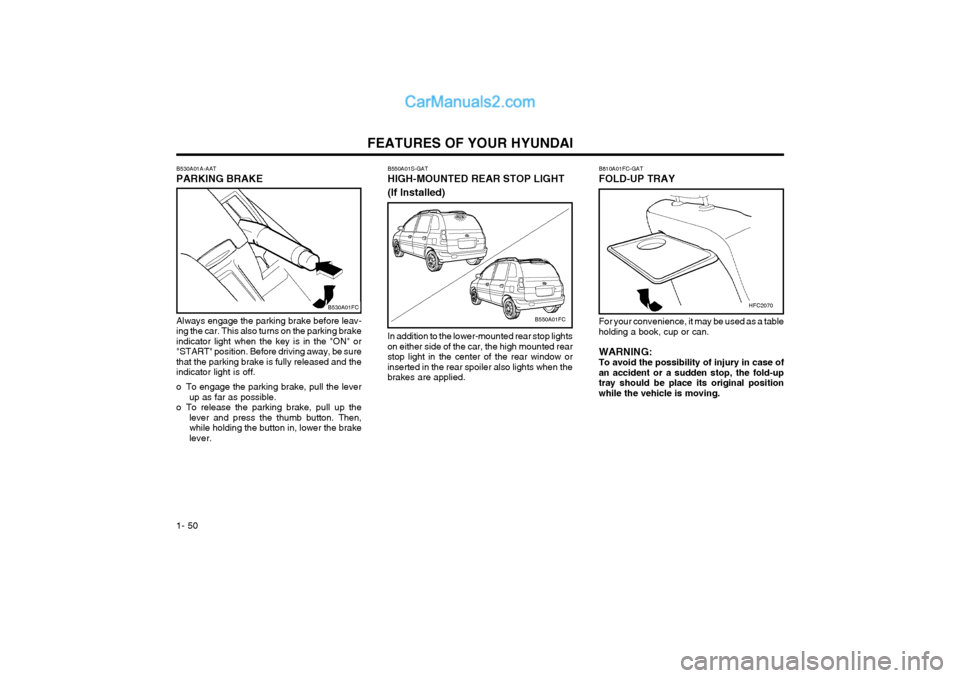
FEATURES OF YOUR HYUNDAI
1- 50 B550A01S-GAT HIGH-MOUNTED REAR STOP LIGHT (If Installed)
B550A01FC
In addition to the lower-mounted rear stop lights on either side of the car, the high mounted rearstop light in the center of the rear window orinserted in the rear spoiler also lights when thebrakes are applied.
Always engage the parking brake before leav-ing the car. This also turns on the parking brakeindicator light when the key is in the "ON" or"START" position. Before driving away, be surethat the parking brake is fully released and theindicator light is off.
o To engage the parking brake, pull the lever
up as far as possible.
o To release the parking brake, pull up the lever and press the thumb button. Then, while holding the button in, lower the brakelever.
B530A01A-AAT PARKING BRAKE
B530A01FC
B810A01FC-GAT FOLD-UP TRAY
For your convenience, it may be used as a table holding a book, cup or can. WARNING: To avoid the possibility of injury in case ofan accident or a sudden stop, the fold-uptray should be place its original positionwhile the vehicle is moving.
HFC2070
Page 78 of 317
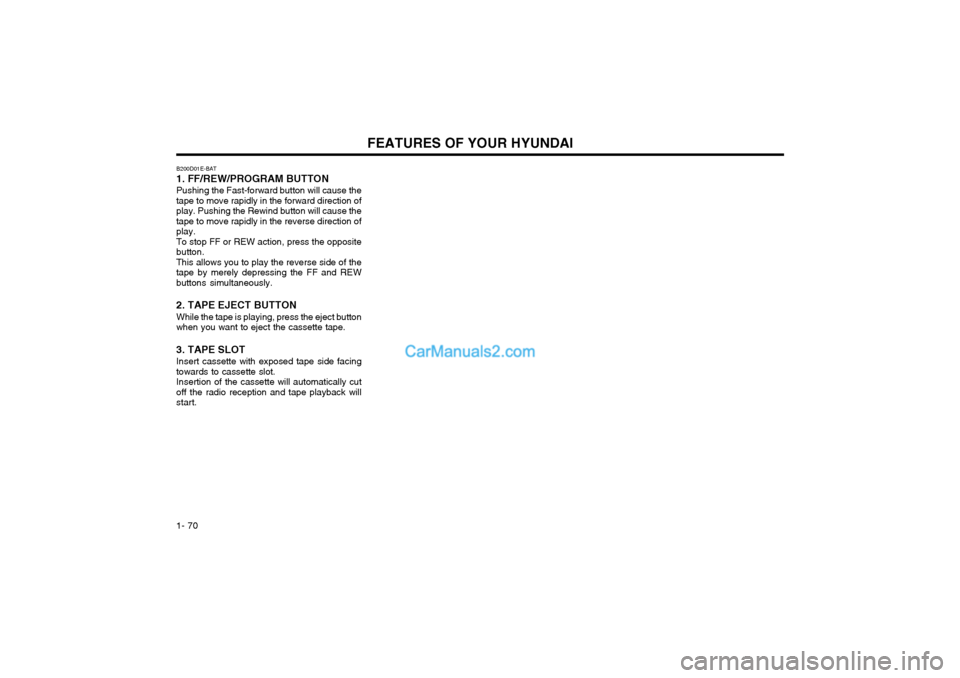
FEATURES OF YOUR HYUNDAI
1- 70
B200D01E-BAT 1. FF/REW/PROGRAM BUTTONPushing the Fast-forward button will cause the tape to move rapidly in the forward direction ofplay. Pushing the Rewind button will cause thetape to move rapidly in the reverse direction ofplay.To stop FF or REW action, press the oppositebutton.This allows you to play the reverse side of thetape by merely depressing the FF and REWbuttons simultaneously. 2. TAPE EJECT BUTTON While the tape is playing, press the eject button when you want to eject the cassette tape. 3. TAPE SLOT Insert cassette with exposed tape side facing towards to cassette slot.Insertion of the cassette will automatically cutoff the radio reception and tape playback willstart.
Page 102 of 317
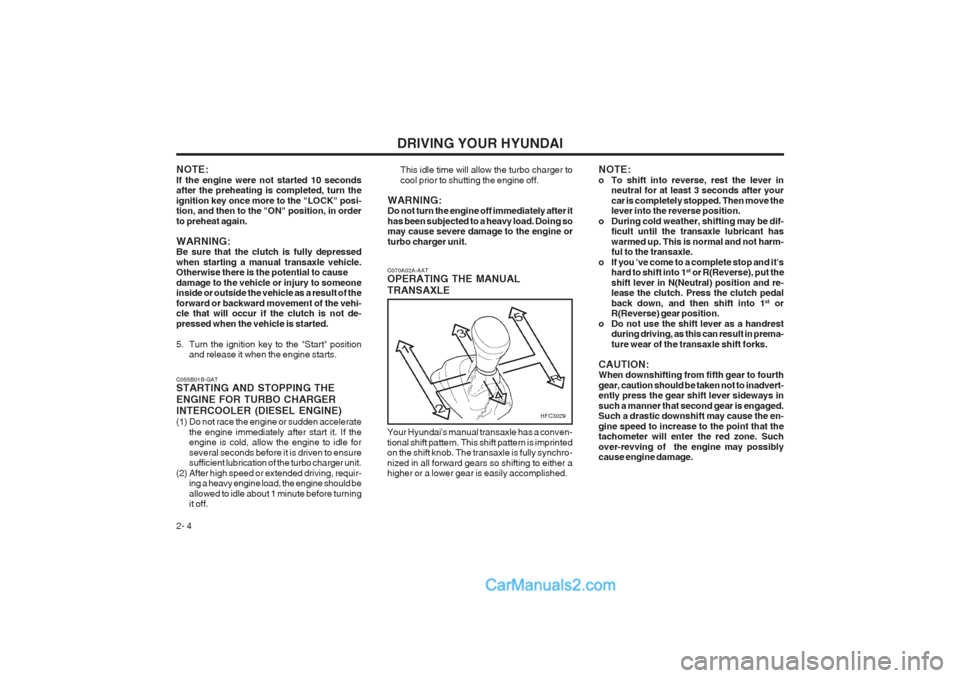
DRIVING YOUR HYUNDAI
2- 4 C070A02A-AAT OPERATING THE MANUAL TRANSAXLE
HFC3029
Your Hyundai's manual transaxle has a conven- tional shift pattern. This shift pattern is imprinted on the shift knob. The transaxle is fully synchro- nized in all forward gears so shifting to either a higher or a lower gear is easily accomplished.
C055B01B-GAT STARTING AND STOPPING THE ENGINE FOR TURBO CHARGER INTERCOOLER (DIESEL ENGINE)
(1) Do not race the engine or sudden accelerate
the engine immediately after start it. If the engine is cold, allow the engine to idle for several seconds before it is driven to ensure sufficient lubrication of the turbo charger unit.
(2) After high speed or extended driving, requir- ing a heavy engine load, the engine should be allowed to idle about 1 minute before turning it off.
NOTE: If the engine were not started 10 seconds after the preheating is completed, turn the ignition key once more to the "LOCK" posi- tion, and then to the "ON" position, in order to preheat again. WARNING: Be sure that the clutch is fully depressed when starting a manual transaxle vehicle. Otherwise there is the potential to cause damage to the vehicle or injury to someone inside or outside the vehicle as a result of the forward or backward movement of the vehi- cle that will occur if the clutch is not de- pressed when the vehicle is started.
5. Turn the ignition key to the "Start" position
and release it when the engine starts. This idle time will allow the turbo charger to cool prior to shutting the engine off.
WARNING: Do not turn the engine off immediately after it has been subjected to a heavy load. Doing so may cause severe damage to the engine or turbo charger unit. NOTE:
o To shift into reverse, rest the lever in
neutral for at least 3 seconds after yourcar is completely stopped. Then move the lever into the reverse position.
o During cold weather, shifting may be dif- ficult until the transaxle lubricant has warmed up. This is normal and not harm- ful to the transaxle.
o If you 've come to a complete stop and it's hard to shift into 1 st
or R(Reverse), put the
shift lever in N(Neutral) position and re-lease the clutch. Press the clutch pedal back down, and then shift into 1 st
or
R(Reverse) gear position.
o Do not use the shift lever as a handrest during driving, as this can result in prema-ture wear of the transaxle shift forks.
CAUTION: When downshifting from fifth gear to fourth gear, caution should be taken not to inadvert- ently press the gear shift lever sideways in such a manner that second gear is engaged. Such a drastic downshift may cause the en- gine speed to increase to the point that the tachometer will enter the red zone. Such over-revving of the engine may possibly cause engine damage.
Page 104 of 317
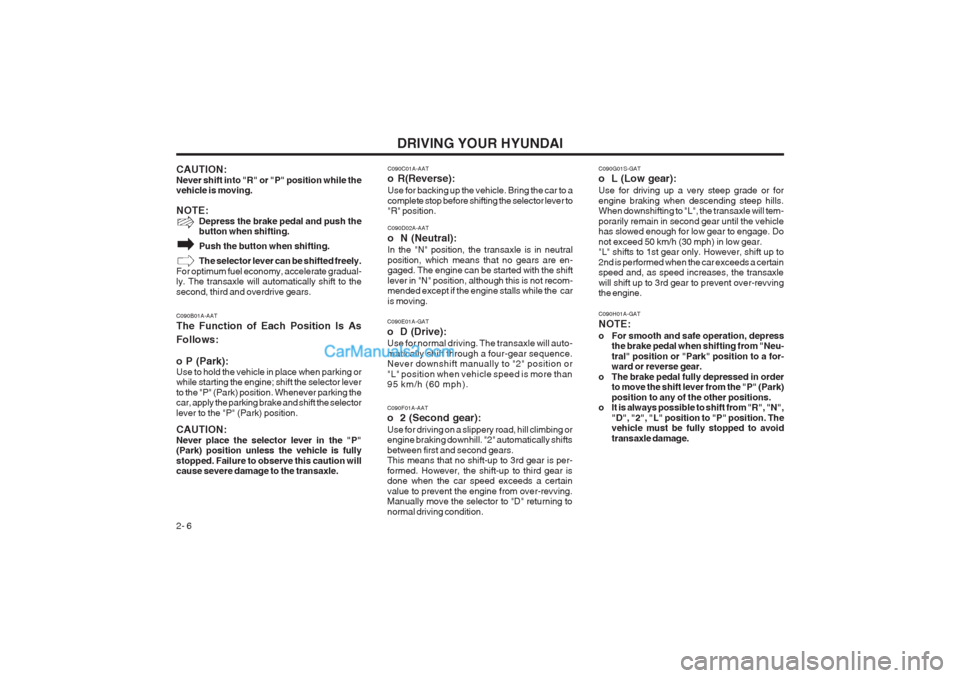
DRIVING YOUR HYUNDAI
2- 6 C090G01S-GAT o L (Low gear): Use for driving up a very steep grade or for engine braking when descending steep hills. When downshifting to "L", the transaxle will tem- porarily remain in second gear until the vehicle has slowed enough for low gear to engage. Do not exceed 50 km/h (30 mph) in low gear. "L" shifts to 1st gear only. However, shift up to 2nd is performed when the car exceeds a certain speed and, as speed increases, the transaxle will shift up to 3rd gear to prevent over-revving the engine.
C090C01A-AAT o R(Reverse): Use for backing up the vehicle. Bring the car to a complete stop before shifting the selector lever to "R" position. C090D02A-AAT o N (Neutral): In the "N" position, the transaxle is in neutral position, which means that no gears are en- gaged. The engine can be started with the shift lever in "N" position, although this is not recom- mended except if the engine stalls while the car is moving.
C090F01A-AAT o 2 (Second gear): Use for driving on a slippery road, hill climbing or engine braking downhill. "2" automatically shifts between first and second gears. This means that no shift-up to 3rd gear is per- formed. However, the shift-up to third gear is done when the car speed exceeds a certain value to prevent the engine from over-revving. Manually move the selector to "D" returning to normal driving condition.
C090E01A-GAT o D (Drive): Use for normal driving. The transaxle will auto- matically shift through a four-gear sequence. Never downshift manually to "2" position or "L" position when vehicle speed is more than 95 km/h (60 mph).
C090B01A-AAT The Function of Each Position Is As Follows: o P (Park): Use to hold the vehicle in place when parking or while starting the engine; shift the selector lever to the "P" (Park) position. Whenever parking the car, apply the parking brake and shift the selector lever to the "P" (Park) position. CAUTION: Never place the selector lever in the "P" (Park) position unless the vehicle is fully stopped. Failure to observe this caution will cause severe damage to the transaxle.
CAUTION: Never shift into "R" or "P" position while the vehicle is moving. NOTE:
Depress the brake pedal and push the button when shifting. Push the button when shifting.The selector lever can be shifted freely.
For optimum fuel economy, accelerate gradual- ly. The transaxle will automatically shift to the second, third and overdrive gears.
C090H01A-GAT NOTE:
o For smooth and safe operation, depressthe brake pedal when shifting from "Neu- tral" position or "Park" position to a for- ward or reverse gear.
o The brake pedal fully depressed in order to move the shift lever from the "P" (Park) position to any of the other positions.
o It is always possible to shift from "R", "N",
"D", "2", "L" position to "P" position. The vehicle must be fully stopped to avoid transaxle damage.
Page 107 of 317
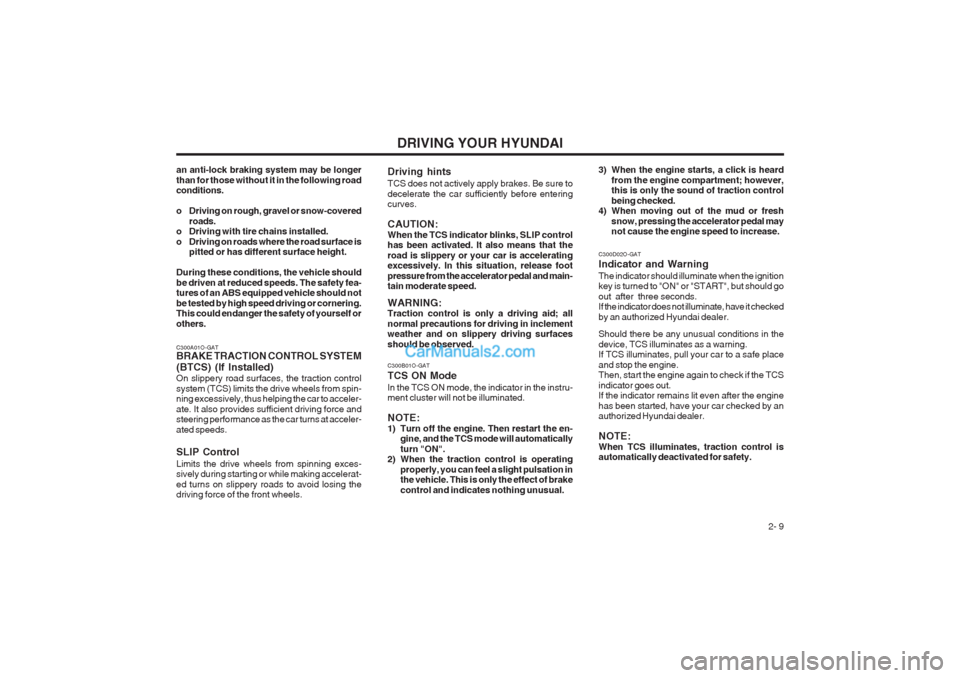
DRIVING YOUR HYUNDAI 2- 9
an anti-lock braking system may be longer than for those without it in the following road conditions.
o Driving on rough, gravel or snow-covered
roads.
o Driving with tire chains installed.
o Driving on roads where the road surface is pitted or has different surface height.
During these conditions, the vehicle shouldbe driven at reduced speeds. The safety fea- tures of an ABS equipped vehicle should not be tested by high speed driving or cornering. This could endanger the safety of yourself or others. C300A01O-GAT BRAKE TRACTION CONTROL SYSTEM (BTCS) (If Installed) On slippery road surfaces, the traction control system (TCS) limits the drive wheels from spin- ning excessively, thus helping the car to acceler- ate. It also provides sufficient driving force and steering performance as the car turns at acceler- ated speeds. SLIP Control Limits the drive wheels from spinning exces- sively during starting or while making accelerat- ed turns on slippery roads to avoid losing the driving force of the front wheels. C300B01O-GAT TCS ON ModeIn the TCS ON mode, the indicator in the instru- ment cluster will not be illuminated. NOTE:
1) Turn off the engine. Then restart the en-
gine, and the TCS mode will automaticallyturn "ON".
2) When the traction control is operating
properly, you can feel a slight pulsation in the vehicle. This is only the effect of brake control and indicates nothing unusual. C300D02O-GAT Indicator and Warning The indicator should illuminate when the ignition key is turned to "ON" or "START", but should go out after three seconds. If the indicator does not illuminate, have it checked by an authorized Hyundai dealer. Should there be any unusual conditions in the device, TCS illuminates as a warning. If TCS illuminates, pull your car to a safe place and stop the engine. Then, start the engine again to check if the TCS indicator goes out. If the indicator remains lit even after the engine has been started, have your car checked by an authorized Hyundai dealer. NOTE: When TCS illuminates, traction control is automatically deactivated for safety.
Driving hints TCS does not actively apply brakes. Be sure to decelerate the car sufficiently before entering curves. CAUTION: When the TCS indicator blinks, SLIP control has been activated. It also means that the road is slippery or your car is accelerating excessively. In this situation, release foot pressure from the accelerator pedal and main- tain moderate speed. WARNING: Traction control is only a driving aid; all normal precautions for driving in inclement weather and on slippery driving surfaces should be observed.
3) When the engine starts, a click is heard
from the engine compartment; however, this is only the sound of traction control being checked.
4) When moving out of the mud or fresh
snow, pressing the accelerator pedal may not cause the engine speed to increase.
Page 108 of 317
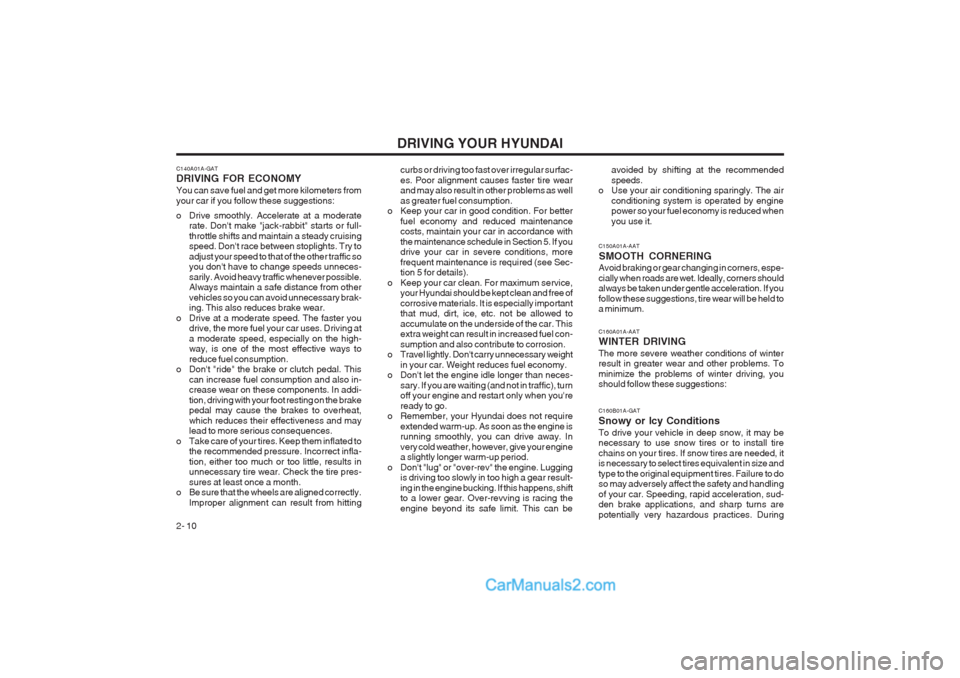
DRIVING YOUR HYUNDAI
2- 10 C150A01A-AAT
SMOOTH CORNERING
Avoid braking or gear changing in corners, espe- cially when roads are wet. Ideally, corners should always be taken under gentle acceleration. If you follow these suggestions, tire wear will be held to a minimum.
curbs or driving too fast over irregular surfac- es. Poor alignment causes faster tire wear and may also result in other problems as well as greater fuel consumption.
o Keep your car in good condition. For better
fuel economy and reduced maintenance costs, maintain your car in accordance with the maintenance schedule in Section 5. If you drive your car in severe conditions, more frequent maintenance is required (see Sec- tion 5 for details).
o Keep your car clean. For maximum service, your Hyundai should be kept clean and free of corrosive materials. It is especially important that mud, dirt, ice, etc. not be allowed to accumulate on the underside of the car. This extra weight can result in increased fuel con- sumption and also contribute to corrosion.
o Travel lightly. Don't carry unnecessary weight
in your car. Weight reduces fuel economy.
o Don't let the engine idle longer than neces-
sary. If you are waiting (and not in traffic), turn off your engine and restart only when you're ready to go.
o Remember, your Hyundai does not require
extended warm-up. As soon as the engine is running smoothly, you can drive away. In very cold weather, however, give your engine a slightly longer warm-up period.
o Don't "lug" or "over-rev" the engine. Lugging is driving too slowly in too high a gear result- ing in the engine bucking. If this happens, shift to a lower gear. Over-revving is racing the engine beyond its safe limit. This can be C160A01A-AAT WINTER DRIVING The more severe weather conditions of winter result in greater wear and other problems. To minimize the problems of winter driving, you should follow these suggestions: C160B01A-GAT Snowy or Icy ConditionsTo drive your vehicle in deep snow, it may be necessary to use snow tires or to install tire chains on your tires. If snow tires are needed, it is necessary to select tires equivalent in size and type to the original equipment tires. Failure to do so may adversely affect the safety and handling of your car. Speeding, rapid acceleration, sud- den brake applications, and sharp turns are potentially very hazardous practices. During
C140A01A-GAT DRIVING FOR ECONOMY You can save fuel and get more kilometers from your car if you follow these suggestions:
o Drive smoothly. Accelerate at a moderate
rate. Don't make "jack-rabbit" starts or full- throttle shifts and maintain a steady cruising speed. Don't race between stoplights. Try to adjust your speed to that of the other traffic so you don't have to change speeds unneces- sarily. Avoid heavy traffic whenever possible. Always maintain a safe distance from other vehicles so you can avoid unnecessary brak- ing. This also reduces brake wear.
o Drive at a moderate speed. The faster you drive, the more fuel your car uses. Driving at a moderate speed, especially on the high- way, is one of the most effective ways to reduce fuel consumption.
o Don't "ride" the brake or clutch pedal. This
can increase fuel consumption and also in- crease wear on these components. In addi- tion, driving with your foot resting on the brake pedal may cause the brakes to overheat, which reduces their effectiveness and may lead to more serious consequences.
o Take care of your tires. Keep them inflated to the recommended pressure. Incorrect infla- tion, either too much or too little, results in unnecessary tire wear. Check the tire pres- sures at least once a month.
o Be sure that the wheels are aligned correctly.
Improper alignment can result from hitting avoided by shifting at the recommendedspeeds.
o Use your air conditioning sparingly. The air
conditioning system is operated by engine power so your fuel economy is reduced when you use it.